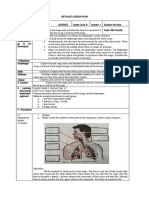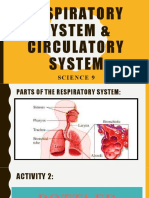Make A Lung
Make A Lung
Uploaded by
Romina Allyssa C. ValdezCopyright:
Available Formats
Make A Lung
Make A Lung
Uploaded by
Romina Allyssa C. ValdezOriginal Title
Copyright
Available Formats
Share this document
Did you find this document useful?
Is this content inappropriate?
Copyright:
Available Formats
Make A Lung
Make A Lung
Uploaded by
Romina Allyssa C. ValdezCopyright:
Available Formats
Build a model lung
Make a model lung you can inflate and deflate.
What you need
• 2 litre plastic bottle • Straws • Scissors • Quality tape • 3 large balloons • Plasticine/Blue Tac • Elastic bands
1. Cut the bottom off the 2 litre bottle, make
the cut a smooth as possible. 3. Add a balloon to each end of the Y-shaped
connector. Secure in place with tape or 5. Create an airtight seal around the straw and
bottle using tape. Alternatively, drill a hole
elastic bands.. in bottle top to thread straw through and
seal with plasticine/Blu Tac.
6. Tie a knot at the end of remaining balloon,
cut balloon in half across largest part. Stretch
2. Create a Y shaped connector.
Cut one straw open (1cm from the end) and 4. Place the balloon and straw connector
structure inside the plastic bottle. Carefully
the balloon, with knot on outside, across
bottom of bottle opening. Tape in place.
fold it out to create two small legs to make a thread the long straw portion through the .
Y. Cut 8cm off the 2nd straw, gently fold in neck of the bottle.
half and cut out a 2cm diamond shape (fold
is in the middle). Place Y of straw 1 over the
diamond shaped hole in straw 2 and tape it
in place. Make the seal airtight.
USE
Gently pull down on the balloon using the knot. This should cause air to be drawn into the lungs (balloons within your
model). Release the knot and watch as the air is expelled (balloons deflate).
The Science
The respiratory system supplies the body with the vital oxygen that the body’s organ needs. When we breathe we take in air through our nose and mouth, and
this is passes via the larynx to the windpipe (trachea). The tube is split into two smaller branches, the bronchi, which goes into the lungs and divides again and
again (bronchioles). The bronchioles have air filled sacs called alveoli which are surrounded by tiny capillaries carrying blood. Oxygen diffuses across the alveoli
membrane through the capillary wall into the blood to be captured by red blood cells and distributed to our organs.
When we breathe in (inhalation) the sheet of muscles (diaphragm) contract pulling the air into the lungs, and when we breathe out (exhalation) the diaphragm
relaxes allowing the lungs to deflate.
Structure of the system
Chest cavity = plastic bottle
Windpipe = straw
Bronchi = Y shaped connector WHAT HAPPENS WHEN I PULL DOWN WHAT HAPPENS WHEN I RELEASE THE
Lung = balloon inside bottle ON THE BALLOON? BALLOON?
Diaphragm = balloon over Inhalation: The volume of the bottle (chest cavity) Exhalation: The volume of the bottle (chest cavity)
bottom of bottle increases which lowers the pressure in the lungs. Lower decreases, forcing air out of the lungs. The lungs
pressure causes air to be drawn into the lungs and the (balloons) contract, returning to their original size.
lungs (balloons) expand as they fill with air.
You might also like
- Lung Model With Two Lungs and Diaphragm LabDocument3 pagesLung Model With Two Lungs and Diaphragm Labrangerblue100% (33)
- Jundi's Homemade Weapon CatalogDocument33 pagesJundi's Homemade Weapon Catalogjugundigi100% (1)
- Bruce Frantzis - Advanced Breathing TechniquesDocument4 pagesBruce Frantzis - Advanced Breathing Techniqueskabshiel100% (2)
- Balloon LungsDocument8 pagesBalloon Lungsaisya abdullahNo ratings yet
- The Diaphragm in Action!: Materials NeededDocument1 pageThe Diaphragm in Action!: Materials NeededWiji Tri UtariNo ratings yet
- Constructing A Lung Model Is An Excellent Way To Learn About The Respiratory System and How The Lungs FunctionDocument3 pagesConstructing A Lung Model Is An Excellent Way To Learn About The Respiratory System and How The Lungs FunctionArevind RajuNo ratings yet
- Teaching Science in The Intermediate Grade: Republic of The Philippines Bulacan State University College of EducationDocument5 pagesTeaching Science in The Intermediate Grade: Republic of The Philippines Bulacan State University College of EducationCarla Briones DionisioNo ratings yet
- Project 1 (Year 8) Equipment: Step-By-Step In-StructionsDocument1 pageProject 1 (Year 8) Equipment: Step-By-Step In-StructionsShereen LinaNo ratings yet
- Document For Activity 2.Document2 pagesDocument For Activity 2.Jhom Angelo BringasNo ratings yet
- Activity 1 Respiratory SystemDocument1 pageActivity 1 Respiratory Systemannegreengables394No ratings yet
- Anatomy and Physiology Laboratory Activity (Respiratory System)Document1 pageAnatomy and Physiology Laboratory Activity (Respiratory System)Benjiesar Gelacio PaltaoNo ratings yet
- Bottled BalloonsDocument9 pagesBottled BalloonskemcanaboNo ratings yet
- Making A Model of LungsDocument6 pagesMaking A Model of LungsKiara KhanNo ratings yet
- The Human Breathing System Part2Document23 pagesThe Human Breathing System Part2Delfin Jr UrbanoNo ratings yet
- Activity 1.1 Science 9Document2 pagesActivity 1.1 Science 9Crzy TiffNo ratings yet
- Materials:: Tittle: Lung ModelDocument2 pagesMaterials:: Tittle: Lung ModelJt JourneymanNo ratings yet
- Pbs Science LungDocument10 pagesPbs Science LungLiyana AziziNo ratings yet
- How Do Lungs WorkDocument1 pageHow Do Lungs WorkTcherKamilaNo ratings yet
- The Bottled BalloonDocument15 pagesThe Bottled BalloonBryan ZapatosNo ratings yet
- Balloon Lung ExperimentDocument4 pagesBalloon Lung ExperimentdyanenfalhadapNo ratings yet
- Activity 1Document1 pageActivity 1Melinda UmpadNo ratings yet
- Lesson Plan in ScienceDocument3 pagesLesson Plan in SciencePRINCESS ANGELLA SITUBALNo ratings yet
- AnabelDocument2 pagesAnabelReah Joy JungcoNo ratings yet
- Human BodyDocument24 pagesHuman Bodyapi-734248685No ratings yet
- Science 9 ActivityDocument4 pagesScience 9 ActivityKATHY CLAIRE BALLEGANo ratings yet
- Bottled BalloonDocument2 pagesBottled BalloonCalexNo ratings yet
- Einsteins Birthday Party PackDocument12 pagesEinsteins Birthday Party PackLucas TobingNo ratings yet
- Repiration Humans Info and Lung Experiment ExplainedDocument15 pagesRepiration Humans Info and Lung Experiment Explainedsusan nobregaNo ratings yet
- Activity No.1 - Bottled BalloonsDocument1 pageActivity No.1 - Bottled BalloonsCristina AguinaldoNo ratings yet
- DhfdjhfjdsDocument21 pagesDhfdjhfjdsMichael EscribaNo ratings yet
- 2024 08 01 Limpopo LFSC Practical Instruction Page Gr11 Test 2 ENGDocument5 pages2024 08 01 Limpopo LFSC Practical Instruction Page Gr11 Test 2 ENGtshireletso.kodisangNo ratings yet
- Modelling Breathing MovementsDocument2 pagesModelling Breathing MovementsDeepti VimalNo ratings yet
- Chemistry I. Title: II. MaterialsDocument26 pagesChemistry I. Title: II. MaterialsDyanne Yssabelle DisturaNo ratings yet
- Performance Task # 1Document2 pagesPerformance Task # 1Romina Allyssa C. ValdezNo ratings yet
- Science 9 Respiratory and Circulatory SystemDocument35 pagesScience 9 Respiratory and Circulatory SystemNobody KnowsNo ratings yet
- Part 2 DDocument2 pagesPart 2 Dapi-513861296No ratings yet
- Science Workshop 25 DemosDocument16 pagesScience Workshop 25 DemosHaha Hoho TNo ratings yet
- 1.a Respiratory System Activites PDFDocument5 pages1.a Respiratory System Activites PDFjoan marie PeliasNo ratings yet
- Science9 Q1Document50 pagesScience9 Q1AILEEN LUZONNo ratings yet
- English Science Worksheet Air FixDocument2 pagesEnglish Science Worksheet Air Fixistichoma ria ulfaNo ratings yet
- Bottled BalloonsDocument2 pagesBottled BalloonsRandolf Cruz100% (1)
- S9.1 Laboratory Work TextDocument4 pagesS9.1 Laboratory Work TextJennie Jane LobricoNo ratings yet
- 2nd Physics Activity Detail0Document2 pages2nd Physics Activity Detail0Abduttaiyeb SutterwalaNo ratings yet
- How Much AirDocument1 pageHow Much AirYashodha RajapakshaNo ratings yet
- Activity 2 - Bottled BalloonsDocument27 pagesActivity 2 - Bottled BalloonsJessica Manawes NavorNo ratings yet
- Mini Vortex CannonDocument1 pageMini Vortex CannonLocal 5 News (WOI-TV)No ratings yet
- SciDocument1 pageSciJasmine Barquilla100% (1)
- CHARLISADocument1 pageCHARLISALanz ValdezNo ratings yet
- Rocket Balloon: Set-Up String & StrawDocument8 pagesRocket Balloon: Set-Up String & StrawRoselle Ann MacadaanNo ratings yet
- Air Pressure DispenserDocument1 pageAir Pressure DispenserALYSSA MAE DAPADAPNo ratings yet
- Jane Goodall's Roots & Shoots Small Peace DovePuppetDocument2 pagesJane Goodall's Roots & Shoots Small Peace DovePuppetThe Jane Goodall InstituteNo ratings yet
- Detailed Lesson Plan in Science 9 I-ObjectivesDocument3 pagesDetailed Lesson Plan in Science 9 I-ObjectivesIRISNo ratings yet
- DIY Tracheostomy Tube Mask and Bag Valve MaskDocument5 pagesDIY Tracheostomy Tube Mask and Bag Valve Maskkyoto.saeopNo ratings yet
- Submarine 1Document2 pagesSubmarine 1amarpal07No ratings yet
- Bernoulli Activities Feb 2019Document2 pagesBernoulli Activities Feb 2019CARLOS ALFREDO ORLANDO VASQUEZ LOPEZNo ratings yet
- Respiratory SystemDocument39 pagesRespiratory SystemJesstine Famatiga100% (2)
- Activity 5. Lung Model: Name Section Date ScoreDocument1 pageActivity 5. Lung Model: Name Section Date ScoreYyyyyyuuuuiiiiivNo ratings yet
- Hovercraft PDFDocument1 pageHovercraft PDFdrthuhanNo ratings yet
- LARP Arrow Construction With ImagesDocument6 pagesLARP Arrow Construction With Imagesgustav_goodstuff8176No ratings yet
- Zenalb 45 PILDocument2 pagesZenalb 45 PILNag RajanNo ratings yet
- Sexual Vs Asexual ReproductionDocument28 pagesSexual Vs Asexual Reproductionalghfelireem24No ratings yet
- MCQDocument24 pagesMCQiqra jabeenNo ratings yet
- Biochemistry of Milk Products 1994Document193 pagesBiochemistry of Milk Products 1994vasile_basliuNo ratings yet
- BIOLOGY II FBI1224 2022 Question Paper 1Document10 pagesBIOLOGY II FBI1224 2022 Question Paper 1zoulzz0903No ratings yet
- SS1 Biology First Term ExaminationDocument14 pagesSS1 Biology First Term ExaminationGodswillNo ratings yet
- 7 Pulmonary EdemaDocument10 pages7 Pulmonary Edemaomar kmr97No ratings yet
- Trigeminal Nerve FinalDocument101 pagesTrigeminal Nerve FinalShraddha PatilNo ratings yet
- Preserving Pulp VitalityDocument2 pagesPreserving Pulp VitalitygsaveitNo ratings yet
- Basics of PharmacologyDocument33 pagesBasics of Pharmacologyshruti bose100% (1)
- Embriologi Alat Kelamin (Deferensiasi Sex)Document20 pagesEmbriologi Alat Kelamin (Deferensiasi Sex)Lavita selviNo ratings yet
- What Is ManganeseDocument2 pagesWhat Is ManganeseOm KarnNo ratings yet
- Biology Science Class 9 Reference BookDocument198 pagesBiology Science Class 9 Reference BookJeevraj MedhiNo ratings yet
- Physical Development of Infants and ToddlersDocument31 pagesPhysical Development of Infants and ToddlersLeo Evidor100% (1)
- Movement Impairment and Low Back Pain Thesis SwedenDocument100 pagesMovement Impairment and Low Back Pain Thesis SwedenwernsickleNo ratings yet
- Pharmacology MCQDocument12 pagesPharmacology MCQNeelam Raj ThakurNo ratings yet
- Insanity WorksheetDocument1 pageInsanity WorksheetShuvajoyyyNo ratings yet
- Accent Method of Voice Therapy For Treatment of Severe Muscle Tension DysphoniaDocument4 pagesAccent Method of Voice Therapy For Treatment of Severe Muscle Tension DysphoniaChrisNo ratings yet
- Lumbar Traction Review2Document9 pagesLumbar Traction Review2Phooi Yee LauNo ratings yet
- McAnime Ligero LNKDocument5 pagesMcAnime Ligero LNKBrandon JoyceNo ratings yet
- Sains Tingkatan 3 - 2Document43 pagesSains Tingkatan 3 - 2Sekolah Portal100% (4)
- Cell-Mediated Immune ResponsesDocument53 pagesCell-Mediated Immune ResponsesFarahdina UmarellaNo ratings yet
- Cloning Vector: Examples of Cloning Vectors Are Plasmids, Cosmids, and Yeast Artificial Chromosomes (Yacs) : PlasmidDocument20 pagesCloning Vector: Examples of Cloning Vectors Are Plasmids, Cosmids, and Yeast Artificial Chromosomes (Yacs) : PlasmidTamajit DattaNo ratings yet
- Sgot TestDocument2 pagesSgot TestShribagla MukhiNo ratings yet
- Science and Health: Digestive SystemDocument17 pagesScience and Health: Digestive SystemEDUARDO ACERONo ratings yet
- Nursing BulletsDocument88 pagesNursing BulletsEunice Lorraine Reyes MarasiganNo ratings yet
- SCIED3.CIERVO - Bsed Sci1-A.laboratory 3 - The Body's FrameworkDocument6 pagesSCIED3.CIERVO - Bsed Sci1-A.laboratory 3 - The Body's FrameworkIrica Mae CiervoNo ratings yet
- Clinical Approach To Respiratory Distress in NewbornDocument29 pagesClinical Approach To Respiratory Distress in Newbornabhivnair100% (1)
- UW Notes - 11 - MSK ArrangedDocument66 pagesUW Notes - 11 - MSK ArrangedDor BenayounNo ratings yet

























































































